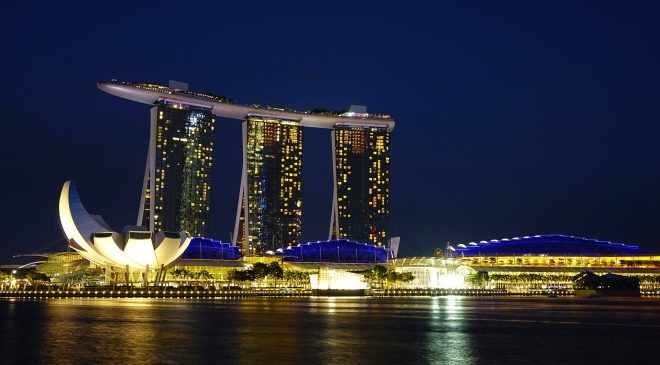Sustainability and energy efficiency are a priority for Ericsson
Singtel today announced the deployment of Singapore’s greenest radio cell, the Ericsson AIR 3268, to its 5G network. This is part of Singtel’s ongoing sustainability and decarbonisation measures towards achieving net-zero emissions by 2050 and paves the way for more such radio cells to be deployed across the country to augment its nationwide 5G coverage.
The AIR 3268 radio is expected to save up to 18 per cent more energy and weighs about 40 per cent less than earlier generations of 5G radios. At just 12kg, its proportions simplify upgrades and make new site acquisitions and installations easy on towers, rooftops, poles, and walls – even in challenging locations. It also makes a 5G site 76 per cent lighter than a 4G site that typically requires multiple radios, while providing the same network capacity. This further reduces Singtel’s overall 5G network energy consumption that is already up to 58 per cent lower than 4G today.
The AIR 3268 is designed to provide real-time channel estimation and ultra-precise beamforming – or elimination of undesirable noise interferences – to accelerate 5G mid-band spectrum deployment, and boost capacity, coverage, and connectivity speeds, thus enhancing mobile experiences for customers.
Anna Yip, Chief Executive Officer, Consumer Singapore, Singtel, said, “We are always looking for ways to deliver Singapore’s greenest 5G network while further reducing our carbon footprint. By integrating energy-efficient technologies into our operations and infrastructure, we aim to build a better, more sustainable future, as we continue to deliver the best network performance and user experience to consumers and enterprises through our 5G solutions and services. With an optimised network, even end-users will be able to conserve energy on their mobile devices, making them part of the movement of building a better future together.
Martin Wiktorin, Head of Ericsson Singapore, and Philippines, said, “Sustainability and energy efficiency are a priority for us at Ericsson. Deploying our energy-efficient AIR 3268 radio as part of Singtel’s 5G network is a significant step in our larger sustainability plan, which is focused on breaking the energy curve by activating energy-saving software, building 5G with precision and operating the site infrastructure intelligently. This will serve to manage mobile traffic growth while reducing energy consumption.”
Deployment simplicity and improved energy efficiency
Singtel 5G is a greener technology with higher data transfer rates compared to any previous wireless technology generation, working on a wide spectrum of 100MHz which provides cell capacity comparable to four Singtel 4G bands combined.
The deployment of the AIR 3268, the lightest and smallest Massive MIMO (multiple-input and multiple-output) in the industry, is another step in Singtel’s energy-saving improvements as it explores smart and sustainable mobile technologies that optimise power and energy utilisation in its operations. See Annex A for more details on Singtel’s sustainability initiatives.
ANNEX A – Examples of some of Singtel’s sustainability initiatives
- Conserving energy through network optimisation. Since 2016, Singtel has implemented efficient power usage techniques such as energy-efficient radio and optimising network algorithms at its mobile base stations to conserve energy in the network, without impacting the user’s access to connectivity when needed. This has been implemented at over 99 per cent of Singtel’s base stations in Singapore, resulting in energy savings of approximately 1,012 MWh/year and GHG emissions avoidance of 413 tCO2e/year.
- Singtel has also switched over 10 conventional uninterruptible power supply (UPS) units at its Singapore data centres to a modular system which is able to optimise energy utilisation based on the number of power modules in operation. This initiative has resulted in energy savings of approximately 767 MWh/year and GHG emissions avoidance of 313 tCO2e/year – equivalent to powering 170 4-room HDB flats for a year.
- Singtel is currently trialling Artificial Intelligence powered MIMO sleep mode to further reduce energy consumption. Maximising and refreshing infrastructure with newer, more efficient technology solutions. Singtel has implemented dynamic spectrum sharing to run its 4G and 5G services simultaneously on the same frequencies via a dual-mode core network, which has eliminated the need for additional new energy-consuming hardware and the operation of two separate core networks.
- It also regularly replaces and overhauls its chiller units and related mechanical and engineering equipment at its various exchanges and office buildings in Singapore. To date, Singtel has replaced 25 out of its 28 chillers, with the remaining three chillers slated for upgrades by the end of next year. This has resulted in energy savings of approximately 1,244 MWh/year and GHG emissions avoidance of 508 tCO2e/year – equivalent to powering 276 4-room HDB flats for a year. Recycling and reducing e-waste. As part of its sustainability goals, Singtel is committed to reducing, reusing and recycling electronic, packaging and corporate waste across its operations and value chain. Together with industry partners, Singtel retired 168 tonnes of e-waste, including IT equipment, electronics and household consumer products from consumers and employees, in FY2022 at a recycling rate of 90 per cent. A further 978 tonnes of e-waste consisting of scrap copper cables were turned into recycled metal.





